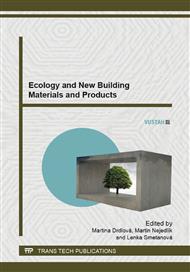[1]
K. Matsui, J. Kikuma, M. Tsunashima, T. Ishikawa, S. Matsuno, A. Ogawa, M. Sato. In situ time-resolved X-ray diffraction of tobermorite formation in autoclaved aerated concrete: Influence of silica source reactivity and Al addition, Cement and Concrete Research, Volume 41, Issue 5, May 2011, Pages 510-519, ISSN 0008-8846.
DOI: 10.1016/j.cemconres.2011.01.022
Google Scholar
[2]
S. Shaw, S.M. Clark, C.M.B. Henderson. Hydrothermal formation of the calcium silicate hydrates, tobermorite (Ca5Si6O16(OH)2·4H2O) and xonotlite (Ca6Si6O17(OH)2): An in situ synchrotron study, Chemical Geology, Volume 167, Issues 1–2, 5 June 2000, Pages 129-140, ISSN 0009-2541.
DOI: 10.1016/s0009-2541(99)00205-3
Google Scholar
[3]
S.A.S. Eℓ-Hemaly, T. Mitsuda, H.F.W. Taylor, Synthesis of normal and anomalous tobermorites, Cement and Concrete Research, Volume 7, Issue 4, July 1977, Pages 429-438, ISSN 0008-8846.
DOI: 10.1016/0008-8846(77)90071-0
Google Scholar
[4]
R. Gabrovšek, B. Kurbus, D. Mueller, W. Wieker, Tobermorite formation in the system CaO, C3S-SiO2-Al2O3-NaOH-H2O under hydrothermal conditions, Cement and Concrete Research, Volume 23, Issue 2, March 1993, Pages 321-328, ISSN 0008-8846.
DOI: 10.1016/0008-8846(93)90097-s
Google Scholar
[5]
N.Y. Mostafa, A.A. Shaltout, H. Omar, S.A. Abo-El-Enein, Hydrothermal synthesis and characterization of aluminium and sulfate substituted 1. 1 nm tobermorites, Journal of Alloys and Compounds, Volume 467, Issues 1–2, 7 January 2009, Pages 332-337, ISSN 0925-8388.
DOI: 10.1016/j.jallcom.2007.11.130
Google Scholar
[6]
N. Narayanan, K. Ramamurthy, Structure and properties of aerated concrete: a review, Cement and Concrete Composites, Volume 22, Issue 5, October 2000, Pages 321-329, ISSN 0958-9465.
DOI: 10.1016/s0958-9465(00)00016-0
Google Scholar
[7]
D. Tunega, A. Zaoui, Understanding of bonding and mechanical characteristics of cementitious mineral tobermorite from first principles, Journal of Computational Chemistry, Volume 32, Issue 2, 30. January 2011, Pages 306–314, DOI 10. 1002/jcc. 21622.
DOI: 10.1002/jcc.21622
Google Scholar


